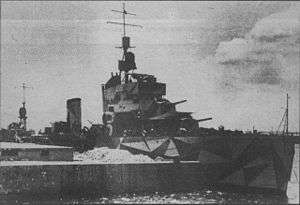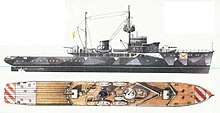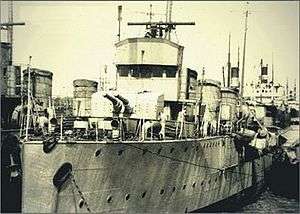Raid on Constanța
| Raid on Constanța | |||||||
|---|---|---|---|---|---|---|---|
| Part of the Black Sea Campaigns of the Eastern Front of World War II | |||||||
 Romanian destroyer Regina Maria | |||||||
| |||||||
| Belligerents | |||||||
|
|
| ||||||
| Commanders and leaders | |||||||
|
|
| ||||||
| Strength | |||||||
|
2 destroyers 1 minelayer destroyer escort 2 motor torpedo boats 1 anti-aircraft battery 1 coastal battery |
Voroshilov Task Force: 1 cruiser 6 destroyers Unknown number of bomber aircraft | ||||||
| Casualties and losses | |||||||
| Port facilities damaged |
1 cruiser damaged 1 destroyer sunk 1 destroyer damaged 9 bombers destroyed 268+ killed 69 captured | ||||||
The Raid on Constanța was an attack of the Soviet Black Sea Fleet on the Romanian port of Constanța on 26 June 1941, resulting in the only encounter between major warships during the naval war in the Black Sea in World War II.
Background

After Romania joined the Tripartite Pact in November 1940, the Germans agreed to construct five coastal batteries to bolster obsolete Romanian coastal defences,[1] including the Tirpitz battery south of Constanța, armed with three spare World War I-vintage model 28 cm SK L/45 guns and protected by 75 mm and 20 mm AA guns. The battery was completed and tested in April 1941 and was operated by 700 Kriegsmarine personnel, although it was nominally under Romanian control like all Axis forces in Romania.[2]
Between 16 and 19 June 1941, in preparation for Operation Barbarossa, the Romanian minelayers Amiral Murgescu, Regele Carol I and Aurora laid 1,000 mines between Cape Midia and Tuzla to protect Constanța.[3]
On 22 June 1941, as part of Operation Barbarossa, Romania launched attacks against Soviet airfields in Bessarabia, destroying many Soviet aircraft on the ground. A retaliatory Soviet bombing raid on Constanța, probably in an attempt to damage the port, was repelled by the Romanian Air Force.[4] The Romanian pilot Horia Agarici was credited with shooting down three Soviet aircraft down during the Soviet bombing raid, and was celebrated as a national hero in a propaganda song.[5] With the failure of the initial air attacks, Soviet Admiral Filipp Oktyabrsky decided to launch a combined aerial and naval attack on Constanța and a seaborne assault on the Danube Delta.[4]
Bombardment


Two Soviet destroyers of the Leningrad class, Moskva and Kharkov, supported by the cruiser Voroshilov,[3][6][7][8][9] the Soobrazitelnyy-class destroyers Soobrazitel'ny and Smyshlyonyi,[10] and two other destroyers, were organized into a task force for the attack. The Soviets also had the battleship Pariskaya Komuna kept 100 miles (160 km) offshore to exploit any initial success, and surviving Soviet bombers also joined in the attack.[4]
The Voroshilov task force approached and shelled Constanța in the early hours of 26 June 1941, setting ablaze some fuel tanks and warehouses,[4] and damaging port infrastructure.[3][6][7][8][9] A Romanian submarine had spotted the Voroshilov task force before it reached its target,[4] and so the Romanian defences, comprising the destroyer Regina Maria and the flotilla leader Mărăști, the minelayer Amiral Murgescu, and the German coastal battery Tirpitz,[3][6][7][8][9] were prepared to quickly retaliate by firing on the Soviet ships. In ten minutes, starting from 03:58, Moskva and Kharkov fired no less than 350 shells from their 130 mm guns. The two Romanian warships opened fire with their 120 mm guns from a distance of 14 miles (22 km) at 04:12, and at 04:20, Kharkov was hit. The Tirpitz battery also opened fire at 04:22. Moskva was also damaged by the Romanian warships, her main mast being brought down by a 120 mm shell while Kharkov was further damaged by Tirpitz.[11][12][13] The surprised Soviets began to retreat, but sailed into a defensive minefield. Moskva was sunk during the retreat, with 268 sailors killed and 69 survivors captured by Romanians.[7][9][14] According to most sources, she was sunk by Romanian mines,[6] although shells from Regina Maria and the Tirpitz coastal battery[15] or an unintentional friendly fire torpedo attack by Soviet submarine Shch-206 have also been suggested as causes.[16] Voroshilov was also damaged by a mine that exploded when Soobrazitel'ny's paravanes triggered it.[17] The Romanian motor torpedo boats Viforul and Vijelia also tried to attack Kharkov, but were driven off by the rest of the Voroshilov task force.[11] The Soviets also lost nine Tupolev SB bombers to anti-aircraft fire during the battle,[4][6][7][8][9][11] two of them claimed by Amiral Murgescu and one by Mărăşti.[3][11] The remaining six aircraft were shot down by a Romanian AA battery of 102 mm Ansaldo guns.[18]
Aftermath
The failure of the raid on Constanța together with the damage suffered by the Black Sea Fleet caused Soviet Admiral Filipp Oktyabrskiy to be much more cautious in his use of surface warships.[14] The next engagement between surface units of the Soviet and Romanian navies would only take place on 18 August, during the Siege of Odessa.
See also
References
- ↑ Jürgen Rohwer, Chronology of the War at Sea, 1939–1945: The Naval History of World War Two, Third Revised Edition. Naval Institute Press, Annapolis, 2005, p. 83, ISBN 9781591141198
- ↑ Robert Kirchubel, Howard Gerrard, Operation Barbarossa 1941: Army Group South, p. 41
- 1 2 3 4 5 Antony Preston, Warship 2001-2002, pp. 70–71
- 1 2 3 4 5 6 Jonathan Trigg, Death on the Don: The Destruction of Germany's Allies on the Eastern Front. The History Press, 2013, pp. 81–82, ISBN 9780750951890
- ↑ "Horia Agarici, "Salvatorul Constanţei", comemorat în oraşul pe care l-a salvat. Eroul a decolat cu aparatul defect şi a doborât trei avioane inamice" (in Romanian). Adevărul. 23 June 2016. Retrieved 26 November 2017.
- 1 2 3 4 5 Robert Forczyk, Where the Iron Crosses Grow: The Crimea 1941–44. Bloomsbury Publishing, 2014, p. 39, ISBN 9781782009764
- 1 2 3 4 5 David T. Zabecki, World War II in Europe: An Encyclopedia, p. 1468
- 1 2 3 4 Richard L. DiNardo, Germany and the Axis Powers from Coalition to Collapse, p. 109
- 1 2 3 4 5 John Jordan, Stephen Dent, Warship 2008, p. 112
- ↑ John Jordan, Stephen Dent, Warship 2009. Anova Books, London, p. 92, ISBN 9781844860890
- 1 2 3 4 Nicolae Koslinski, Raymond Stănescu, Marina română in al doilea război mondial: 1941-1942 (in Romanian)
- ↑ Antony Preston, Warship 2001-2002, p. 71
- ↑ Lawrence Paterson, Steel and Ice: The U-boat Battle in the Arctic and Black Sea 1941-45
- 1 2 Robert Forczyk, Where the Iron Crosses Grow: The Crimea 1941–44. Bloomsbury Publishing, 2014, p. 33, ISBN 9781782009764
- ↑ Feri Predescu (26 June 2015). "26 iunie 1941- Primul atac al Flotei Sovietice, respins de Forţele Navale Române. Viceamiralul Petre Zamfir, participant la scufundarea distrugătorului „Moskva"" [June 26th 1941 – The First Attack of the Soviet Navy, repelled by the Romanian Navy. Rear Admiral Peter Zamfir, Participant in the Sinking of the Destroyer "Moskva"]. Evz.ro. Retrieved July 11, 2016. (in Romanian)
- ↑ "Лидер "Москва"" [Leader "Moskva"]. Sevastopol Fleet Information Resource (in Russian). Retrieved July 11, 2016.
- ↑ Jürgen Rohwer, Chronology of the War at Sea, 1939–1945: The Naval History of World War Two, Third Revised Edition. Naval Institute Press, Annapolis, 2005, pp. 82–83, 101, ISBN 9781591141198
- ↑ Adrian Storea, Gheorghe Băjenaru, Artileria română în date și imagini (Romanian artillery in data and pictures), p. 110 (in Romanian)